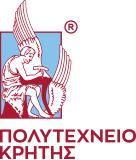Ημερολόγιο Εκδηλώσεων
28
Αυγ

 28/08/2023 12:00 - 14:00
28/08/2023 12:00 - 14:00 Σύνδεσμος τηλεδιάσκεψης: https://tuc-gr.zoom.us/j/99095968628?pwd=ZEpqTjlxZFhWTnJYbExGL0JUT1g4dz09
Σύνδεσμος τηλεδιάσκεψης: https://tuc-gr.zoom.us/j/99095968628?pwd=ZEpqTjlxZFhWTnJYbExGL0JUT1g4dz09ΠΟΛΥΤΕΧΝΕΙΟ ΚΡΗΤΗΣ
ΣΧΟΛΗ ΜΗΧΑΝΙΚΩΝ ΠΑΡΑΓΩΓΗΣ ΚΑΙ ΔΙΟΙΚΗΣΗΣ
Ονοματεπώνυμο: ΠΑΠΑΝΙΚΟΛΑΟΥ ΕΥΣΤΑΘΙΟΣ
Αριθμός Μητρώου: 2017019058
Θέμα:
Τίτλος στα Αγγλικά:Strategies and implication of supply chain integration with blockchain
Επιτροπή:
Επιβλέπων: Βασίλειος Μουστάκης, Καθηγητής, Σχολή ΜΠΔ
Πρώτο Μέλος: Φώτης Πασιούρας, Μέλος τριμελούς επιτροπής, Καθηγητής Montpellier Business School
Δεύτερο Μέλος: Γιάννης Αγγελής, Μέλος τριμελούς επιτροπής, Αναπληρωτής Καθηγητής, ΚΤΗ Royal Institute of Technology, Σουηδία
Τρίτο Μέλος: Κωνσταντίνος Ζοπουνίδης, Καθηγητής, Σχολή ΜΠΔ
Τέταρτο Μέλος: Ιωάννης Μαρινάκης, Καθηγητής, Σχολή ΜΠΔ
Πέμπτο Μέλος: Στέλιος Τσαφαράκης, Αναπληρωτής Καθηγητής, Σχολή ΜΠΔ
Έκτο Μέλος: Βασίλειος Ζεϊμπέκης, Επίκουρος Καθηγητής, Τμήμα Μηχανικών Οικονομίας και
Διοίκησης Πανεπιστήμιο Αιγαίου
Περίληψη Διατριβής στα Αγγλικα:
Distributed Ledger Technology (DLT), or else blockchain, enables new ways of inter-firm interaction in a networked environment. DLT is in its primitive stage of development and many organizations in various industries experiment with it to realize its boundaries and benefits that stem from it in practice. In today’s globalized economy, effectiveness and efficiency of supply chain operations depend upon the synchronization and coordination of organization’s processes, departments and external entities, that intersect supply chain operations. Those supply chain touchpoints seem to leave some space for DLT adoption at supply chain level, due to the trust issues, uncertainties and vulnerabilities that are raised in relationships among interacting entities. The same applies in the case that those touchpoints are referred to the internal or external intersections of organization’s supply chain processes for each individual supply chain entity.
Although DLT has long way to go until widely adopted, companies proceed mainly with pilot supply chain implementations to explore its benefits. Supply chain digitalization is becoming the center stage in developing manufacturers' competitive advantage. However, research shows that supply chains are facing information exchange and trust issues and that makes DLT an ideal candidate to address those challenges. Technology itself has no singe objective value. When it is commercialized in some way by a business model then its economic value becomes apparent. Business model innovation is associated with the capability of an organization to commercialize new ideas and technologies or to depict the variations on a generic value chain. DLT brings fundamental changes in the way that value is exchanged, transactions are executed among ecosystem actors and ecosystems interact. Business model represents the value logic of an organization and articulates how a company goes to the market to implement a strategy. It is the link between the strategy and the operative implementation.
Existing literature has discussed the potential of DLT to transform the supply chain, but limited work has been taken into exploring the impact of DLT to the respective business model. Although business model innovation literature is referred to the aspect of technological advances as one of its main drivers, the impact of DLT implementation at supply chain level on manufacturers’ business model has not been addressed. We acknowledge and set at the center of our research the fact that in a highly dynamic environment, where different types of relationships coexist, supply chain collaboration is inextricably linked with information sharing capabilities and trust dynamics developed among interacting parties. To close that gap in literature, we select an inductive, qualitative multiple case study approach to answer the first main research question (mRQ1) of “What are the implicit effects in business model that stem from DLT adoption”, under a manufacturing supply chain context.
The main source of evidence of the multi-case study research consists of semi-structured interviews with elite informants of 25 large manufacturing companies established in 8 European countries. Between December 2020 and April 2021 two rounds of remote and on-premises interviews, lasting approximately 90 minutes each, have been conducted with each elite informant from each one of the 25 manufacturing companies. Based on findings we identified how DLT adoption under a manufacturing supply context leads to activities, intents and decisions that affect organization’s business model elements. We map how and which business model dimensions are affected and provide managers a method to analyze and assess which DLT related supply chain decisions will affect which business model dimensions; we present the respective process model.
In our study we confirm the common view that trust among interacting parties is the main DLT adoption driver. This is expected given the stated role and benefits of DLT adoption in both literature and practice. We focused our research on the intersection of the organization with its interacting entities external to the company in a business ecosystem context to explore how DLT adoption impacts business models. We concluded that it is too simplistic to argue that trust and data openness are implicit business model effects. Our study results revealed that supply chain partner selection and substitution, process and transaction redesign, generation of new knowledge, rules and incentive of collaboration constitute the secondary business model effects stemmed by DLT adoption. Our results show that DLT adoption initiates the transformation of trust and supply chain collaboration between the organization and its supply chain interconnected parties at ecosystem level. The process model developed presents a dynamic picture of a sequence of processes comprised of activities and intents that indicate the secondary effects on business model dimensions.
Peer-to-peer transactions among network members, the large number of network participants that ensure both DLT security and the need for positive network effects, highlight the need to argue for an ecosystem approach, where actors create value for actors, when investigating DLT adoption. DLT can be adopted and drive value creation in different ecosystem types, Therefore, before we explore DLT adoption, under a manufacturing supply chain context, we need to clarify what ecosystem type should we consider when we discuss DLT and direct our research regarding the first main research question based on the selected ecosystem type analogies to DLT ecosystem conceptualization. We argue that the economic community consisted of organizations, that although independent, are connected and interact through DLT form the DLT ecosystem. DLT can be applicable in many ecosystem types. However, little research has been done on how DLT works in all ecosystem types. We acknowledge specific ecosystem characteristics in a DLT network of actors and argue that there are similarities between various ecosystem types. Our study extends DLT and ecosystem literature by answering the research sub-question (subRQ1.1) “How do ecosystem types make fit to DLT?”. Seeing DLT as an innovative digital technology that designates the transactions between ecosystem members, we selected to examine the software, digital, technological, innovation, product and service ecosystem types as concepts closer to DLT ecosystem. We revealed their similarities to DLT business ecosystem and spotted their key attributes that make them to deviate from the DLT business ecosystem approach. From that comparison we deduced that each one of those ecosystems can be developed within the DLT business ecosystem. They can also be a subset of it but do not match DLT ecosystem key attributes and do not meet its objectives. We concluded that this can be achieved only by the business ecosystem approach. Therefore, answering the second part of our research sub-question on what ecosystem type is closer to DLT concept we reviewed the business ecosystem approach. To make it apparent we mapped the business ecosystem analogies to DLT ecosystem and identified the similarities between these two concepts.
We argue that when we investigate DLT adoption under an ecosystem conceptualization we need to consider the roles that ecosystem actors hold in it under the context of ecosystem sustainability. DLT value lies in the sustainability of the DLT network, since value created in DLT network is collectively produced by its members. In that way we can investigate more accurately the DLT adoption causations, since different DLT ecosystem roles in a highly dynamic environment lead to different DLT adoption incentives. We build upon ecosystem conceptualization, due to DLT network effects and extend DLT literature by answering the research sub-question (subRQ1.2) of “How DLT ecosystem actors based on their role, contribute to ecosystem sustainability?”. Little research has been done on how DLT actor roles affect DLT ecosystem sustainability in a highly dynamic environment, where exchange of trusted data play fundamental role in meeting DLT ecosystem sustainability.
We identified that DLT architecture and actor roles are of major importance for ecosystem sustainability. Power and attitude of dominant ecosystem players regarding ecosystem relationships are the fundamental pillars of DLT ecosystem sustainability. Niche players, analogical to business ecosystem literature, constitute the non-dominant group of actors in DLT ecosystem. Their participation in it is associated with ecosystem’s scale up and sustainability potential. We argued that if niche actors feel that either contribute with low value creation or enjoy disproportional amount of value created by the network, they will be demotivated to participate in it and eventually undermine ecosystem’s sustainability. It is therefore apparent that deep versus superficial collaboration is necessary for DLT ecosystem survival and that dominant DLT ecosystem actors need to push towards that direction. This conclusion is aligned with the common fate of all ecosystem actors that participate in DLT ecosystem.
In our research we explored DLT ecosystem dynamics and under that prism we identified that ecosystem balance, robustness, productivity, niche creation, scalability, flexibility, actor aligned goal, activities and interdependency are DLT ecosystem sustainability factors. We eventually presented the endogenous and exogenous forces that affect DLT ecosystem evolution. We argued that co-evolution based in knowledge and resource transfer, DLT architecture, actor relationship types and role changes in a highly dynamic ecosystem environment form the main endogenous factors of evolution. On the other end market changes, changes in economic and social environment, technological change and regulations have been considered that constitute the respective exogenous factors.
Based on the most recent DLT developments, we identify the ecosystem dynamics for the DLT business ecosystem type as identified when answering the first research sub-question and propose the factors that should be considered for its sustainability. Under that condition, we emphasize in network effects created in ecosystem and cluster actor roles according to their dominant or non-dominant position they hold in it. To gain a holistic overview of DLT supply chain adoption we expand our research beyond the profound interaction of organization’s supply chain with entities external to the organization, as answered by the first main research question. Therefore, we argue that we also need to look internal to the organization for the respective DLT in-house supply chain adoption causations. DLT does not seem, at least at first sight, to have much to contribute unleashing its potential under an in-house supply chain context.
In that part of our research, we initially investigate whether internal supply chain touchpoints leave ground for conveying DLT benefits, thus answering the second main research question (mRQ2) of ‘How DLT adoption causations at in-house supply chain level impact organization’s business model?”. In the absence of evidence in literature we base our study on carefully selected qualitative inductive single case study research (home appliance original equipment global manufacturer-‘HA-OEM’). Εxtensive data had been collected during interviews conducted in four phases. Key informants were located in four production plants, three in E.U and one overseas. In one E.U. production plant, hereafter called Plant A, interviews were conducted on-premise. Plant A that has been the Plant which provided the main source of data through on-premise visits had gained, once over the last 5 years (2018-2022), the “Best PPC System” recognition, among all HA-OEM production plants. Between Sept 2021 and March 2022 20 semi-structured interviews with 18 informants located into four selected HA-OEM production plants and 3 on premise visits to one selected, E.U, based production plant, where researchers conducted multiple source data collection.
Based on the findings we set out to advance our understanding of DLT adoption impact on the business model dimensions. To understand to what extent business model is affected by DLT implementation at in-house supply chain level, we initially unpack it into its dimensions and evaluate how each one of them is affected by DLT implementation root causes. After we have complete overview of the processes that led to DLT in-house supply chain adoption causation. we portray a process model, that reflects the process of DLT in-house supply chain adoption, the dynamic relationships among the emergent concepts and its impact on organization’s business model.
To evaluate the impact of DLT adoption at in-house supply chain operations on the business model, we will assess the respective impact of the five aggregated dimensions that have been proven to drive DLT adoption. For that reason, we selected to use the Velu (2018) business model architecture. That proposition contains the most widely accepted business model dimensions, meaning the value creation, value proposition, value capture and adds the value network dimension that reflects the network facet of DLT. Research revealed that that Information Asymmetry has, by far, the higher impact on business model. Since in-house supply chain operations mainly refer to product configuration and production, value creation dimension has been found to be the most heavily impacted dimension, as expected, followed by the value network dimension.
Research results show that in manufacturer’s MTO, supply chain departments’ intention to trust is not static. It is rather transformed based on the measured impact on all supply chain interconnected parties. Hence, competence and integrity, being among the most widely recognized dimensions of ‘trust-in-organization’ models are the key parameters that gauge trust level achieved through supply chain department collaboration and interactions with internal and external to the organization supply chain entities. Research data revealed that in efficient supply chains there is strong trust between internal and external parties. However, competition among interacting parties typically remains. Research data show that in a well-structured supply chain, the single source of truth, as promised by DLT, should be in place to expose competitive behavior that undermines in-house supply chain operational efficiency. Although data capture through highly integrated information systems enhances data driven decision making, gaps in data records, information sharing inefficiencies, resource consuming audits and lack of ‘near-real-time’ information exchange, lay the ground for inefficiencies in data driven decisions and cross functional collaboration. In respect to information held and shared internal to the company, the research revealed inefficiencies in the information mining and sharing processes. Customer feedback analysis bottleneck, trusted production planning data needed for PPC reviews, data synchronization between production lines, interdepartmental collaboration issues and internal communication inefficiencies due to misperceptions or delays in data matching, revealed supply chain ‘effort-level’ information asymmetries. Findings highlighted the significance of information sharing and exchange mechanisms between company departments and especially those related to planning, inventory management, and PPC. The role of DLT coincides with in the role of a mechanism, which ensures that competent interacting actors will perform their tasks meeting the standards set. By gaining experience, companies become more competent as they improve certain skills and become more knowledgeable. Data openness, bilateral visibility and transparency on interacting actors’ data, reduces information asymmetry pushing manufacturing supply chains to advance their competencies.
In the absence of literature regarding how DLT adoption at in-house supply chain level, could impact manufacturing leanness, we build upon the findings of the mRQ2 to answer the research sub-question (subRQ2.1) of “To what extend could DLT adoption impact manufacturing leanness?” Based on the elite informants engaged in single case study data collection for the purpose of answering the mRQ2, we collect and analyze data under the assumption that DLT adoption will only affect the information flow and no other material flow lean improvement technique will be considered. We employ the value stream mapping methodology (VSM), to depict the simulated future state under our assumptions We eventually illustrate and evaluate which and to what extend manufacturing streams throughput time (TT) is impacted. Based on our findings, eight (8) out of thirteen (13) manufacturing streams demonstrated reduced TT by 0,61% to 3,81%, due to DLT adoption, that has been found to be mainly caused by the overall equipment effectiveness improvement (OEE) Moreover, total TT as well as the critical manufacturing stream have been found to remain unchanged.
Ημερομηνία Εξέτασης
Ημέρα/Μήνας/Έτος: Δευτέρα 28/08/2023
Ώρα: 12:00 – 14:00
Χώρος Εξέτασης
Σύνδεσμος (Link):
https://tuc-gr.zoom.us/j/99095968628?pwd=ZEpqTjlxZFhWTnJYbExGL0JUT1g4dz09
Αίθουσα: Αίθουσα Συνεδριάσεων της Σχολής Μηχανικών Παραγωγής και Διοίκησης
Κτίριο: ΜΠΔ













